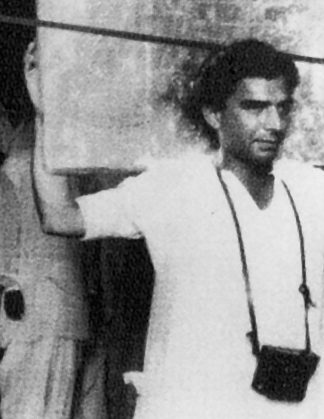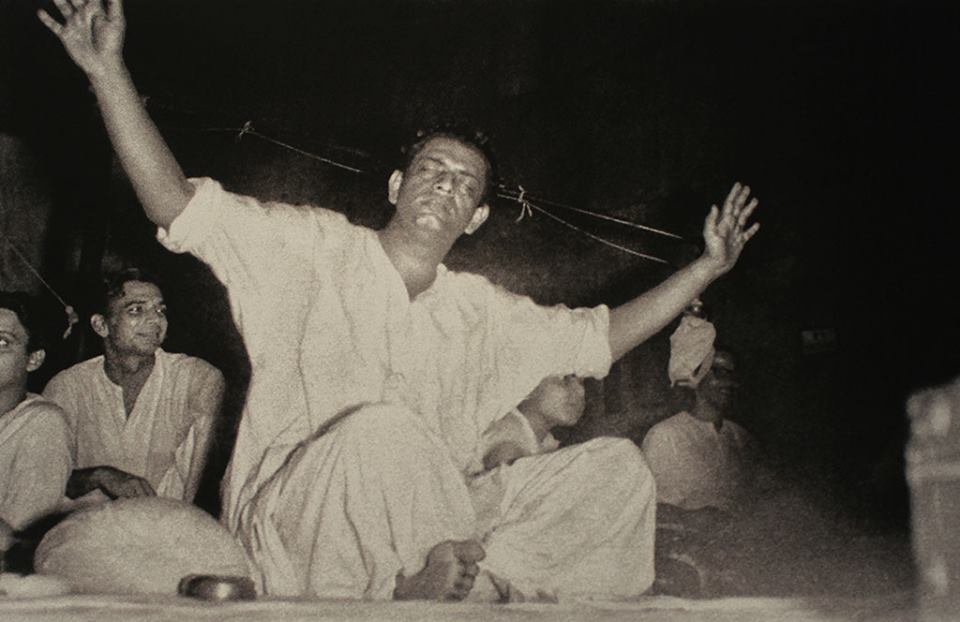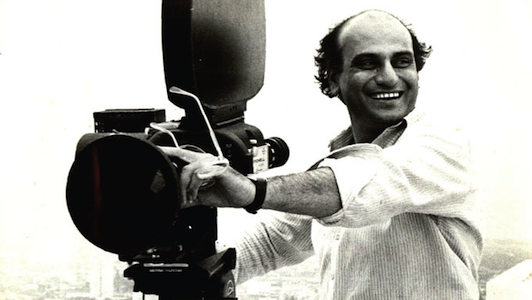Bansi Chandragupta
Bansi Chandragupta (* 1924 in Sialkot, Punjab, † June 27, 1981 in Brookhaven, New York) was an Indian Designer and documentary film director who worked in Bengali and Hindi film. Particularly intense was his collaboration with the director Satyajit Ray.
Life
Bansi Chandragupta was born into a Kashmiri Pandit family and grew up in Srinagar. He was interested in painting as a child after school and learned the painter and art collector Subho Tagore (1912-1985) - a nephew of Rabindranath Tagore - who invited him to study in Kolkata, and let him live in his apartment at the Metropolitan Building, which also houses the library of the United States Information service ( USIS ) was housed. There and in artistic circles Kolkataer learned Chandragupta Satyajit Ray and other art lovers know. With Ray, Chidananda Dasgupta and Dasgupta Harisadhan he was among the first members of the Calcutta Film Society, which had the performance of foreign art films directed.
His first active experience with the film was Chandragupta in 1947 when he was Subho Tagore, the production designer of the film Abhijatri by Hemen Gupta, assisted. After Tagore had fallen out with Gupta and the producer and writer Jyotirmoy Roy due to artistic differences and the Ersatzszenenbildner became ill, Chandragupta was rather transferred the work by accident. When Jean Renoir came to India in 1950 and his film The River turned, Bansi Chandragupta was hired as an assistant to the film production designer Eugène Lourié and learned the importance of the design of the film sets to know for the entire work. His experience gained with the design of realistic film sets he used in Satyen Bose's Bhor Hoye Elo (1953 ) and received attention among Bengali filmmakers. For the resulting Pather Panchali Chandragupta at the same time created an authentic set of village huts, equipped with furniture and everyday household goods, which contributed significantly to the credibility of the playing in the milieu of rural poverty film. The story about the boy Apu won international awards and was the first of up to 1970 permanent ongoing collaboration with his friend Ray Chandragupta. A total of 20 films together, where Ray had transformed his concrete ideas of Filmbauten of Chandragupta created.
For Aparajito (1956 ), the second film of the Apu Trilogy, Chandragupta built on the outside area of the Kolkataer " Technicians 'Studio ' The Inside View of Apartment from Apu's family in Benares after. The open-topped buildings were covered by an idea of the cameraman Subrata Mitra with white fabric which let through the light of day, without that it cast shadows. The work of these two technicians made it even to the trained eye is not always easy to distinguish between the original and places Studionachbauten. For the best quality in this respect Ray Mitra Chandragupta productions include Charulata (1964 ) with the replica of a villa of the Bengali upper class in the late 19th century and Nayak (1966 ), with interiors Rajdhani Express are all studio sets. The established with Ray and Mitra procedures applied Chandragupta even in his films with Mrinal Sen - Baishey Shravan (1960), Akash Kusum (1965 ), Akaler Sandhaney (1980 ) - and Tarun Majumdar - Ektuku Basha (1965) and Balika Bodhu (1967 ) - at.
After the production of Pratidwandi (1970 ) Chandragupta Rays left film crew - as already Subrata Mitra - due to artistic differences, and went to Bombay, where he was henceforth work for the Hindi film. Critical of the quality of buildings in the usual commercial Hindi film was Chandragupta mainly work with young FTII graduates Kumar Shahani as whose debut film Maya Darpan (1972 ), he endowed. He worked at Piya Ka Ghar (1972) and Manzil (1979 ) with Basu Chatterjee, but also for the international Merchant Ivory productions, The Guru (1969 ), Mahatma and the Mad Boy ( 1974), and Hullabaloo Over Georgie and Bonnie 's Pictures ( 1978).
In Satyajit Ray's Shatranj Ke sole nichtbengalischen feature film Khilari (1977 ), there was a last collaboration between the two. The film takes place at the end of the reign of Wajid Ali Shah in the Muslim Kingdom of Avadh and has the annexation by the British in 1856 on the topic. During the preparations studied Chandragupta and Ray, among other contemporary paintings of the Nawab Haidar Ghaziuddin and miniatures, which are known for their Detailhaftigkeit. From one of the paintings they copied the look of the throne used in the film of the Nawab of Avadh. For Muzaffar Ali's Umrao Jaan (1981 ) Chandragupta created a second time costumes and the court of the Nawab in Lucknow.
To Chandragupta's recent work includes Shyam Benegals Kalyug (1981 ), Aparna Sen 36 Chowringhee Lane and in 1984 published by Tarang Kumar Shahani. In Sens film Chandragupta designed according to the living environment of Anglo - Indians in Kolkata. The work is dedicated Bansi Chandragupta. His work influenced young Designer as Nitish Roy, Nitin Desai Samir Chanda or.
Besides his work as Production Designer Chandragupta shot several documentaries that were produced by the Government of West Bengal. Of these won Glimpses of West Bengal (1967), a National Film Award.
Bansi Chandragupta died at the age of 57 years at Brookhaven Memorial Hospital on Long Iceland (New York) after a heart attack he suffered when he was running for a train. He was with Satyajit Ray and Chidananda Das Gupta in the U.S. to open a organized by the Museum of Modern Art retrospective of Indian films.










